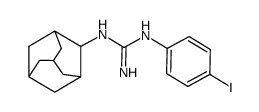| Cas No.: | 193527-91-2 |
| Chemical Name: | 1-(4-Iodophenyl)-3-(2-adamantyl)guanidine |
| SMILES: | N(C1=CC=C(I)C=C1)C(=N)NC1C2CC3CC1CC(C3)C2 |
| Formula: | C17H22In3 |
| M.Wt: | 395.29 |
| Purity: | >98% |
| Sotrage: | 2 years -20°C Powder, 2 weeks 4°C in DMSO, 6 months -80°C in DMSO |
| Publication: | [1]. James M Brimson, et al. Simple ammonium salts acting on sigma-1 receptors yield potential treatments for cancer and depression. Sci Rep. 2020 Jun 8;10(1):9251. [2]. Halley M Oyer, et al.Small-Molecule Modulators of Sigma1 and Sigma2/TMEM97 in the Context of Cancer: Foundational Concepts and Emerging Themes. Front Pharmacol. 2019 Oct 21;10:1141. [3]. Felix J Kim, et al. Inhibition of tumor cell growth by Sigma1 ligand mediated translational repression. Biochem Biophys Res Commun. 2012 Sep 21;426(2):177-82. |
| Description: | IPAG is a prototypic selective inhibitor of sigma1 receptor that engages the unfolded protein response and induces autophagy in cancer cells. |
| In Vivo: | Sigma1 inhibition by IPAG causes the autolysosomal degradation of PD-L1 in PC3 (hormone-insensitive prostate cancer) and MDA-MB-231 (triple-negative breast cancer) cell lines and reduces the levels of functional PD-L1 on the surface of the cells[2]. IPAG treatment produces a mean of 100±8 μg per 106 cells. IPAG can inhibit cell proliferation. Treatment with IPAG decreases cell mass[3]. IPAG treatment suppresses phosphorylation of translational regulator proteins p70S6K, S6, and 4E-BP1[3]. Cell Viability Assay[3] Cell Line: T47D cells Concentration: 10 μM Incubation Time: 24 hours Result: The mean forward scatter height (FSC-H) of DMSO (control) measured 412±5, whereas the mean FSC-H of IPAG treated cells was 390±4. Western Blot Analysis[3] Cell Line: T47D cells Concentration: 10 μM Incubation Time: Result: Decreased levels of phospho-threonine 389-p70S6Kinase (P-S6K), phospho-serine 235/236-ribosomal S6 (P-S6), and phospho-serine 65-4E-BP1 (P-4E-BP1). |
| References: | [1]. James M Brimson, et al. Simple ammonium salts acting on sigma-1 receptors yield potential treatments for cancer and depression. Sci Rep. 2020 Jun 8;10(1):9251. [2]. Halley M Oyer, et al.Small-Molecule Modulators of Sigma1 and Sigma2/TMEM97 in the Context of Cancer: Foundational Concepts and Emerging Themes. Front Pharmacol. 2019 Oct 21;10:1141. [3]. Felix J Kim, et al. Inhibition of tumor cell growth by Sigma1 ligand mediated translational repression. Biochem Biophys Res Commun. 2012 Sep 21;426(2):177-82. |

 DC Chemicals' products qualify for U.S. tariff exemptions. We guarantee no price increases due to customs duties and maintain stable supply, continuing to deliver reliable research solutions to our American clients.
DC Chemicals' products qualify for U.S. tariff exemptions. We guarantee no price increases due to customs duties and maintain stable supply, continuing to deliver reliable research solutions to our American clients.





















